
Check Point Compliance Software Blade
Monitors your management, Software Blades and security
gateways
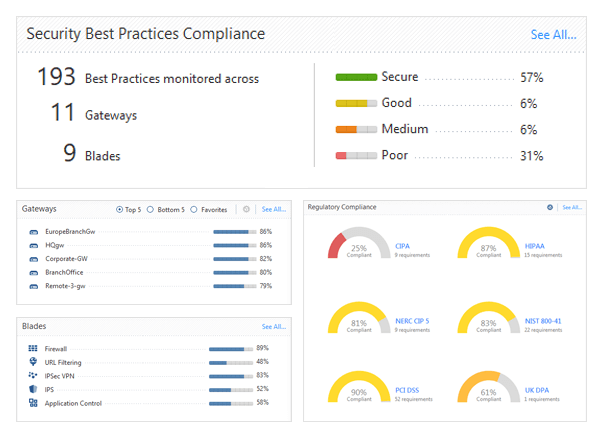
Boost your security level across your entire Check Point
environment with a dynamic security compliance solution that
continuously monitors your security infrastructure, gateways,
blades, policies and configuration settings all in real time.
Overview:
Boost your security level across your entire Check Point environment with a dynamic security compliance solution that continuously monitors your security infrastructure, gateways, blades, policies and configuration settings all in real time.

Increased Security
Detects poor configurations against 300+ Check Point Security Best Practices

Avoiding Human Error
Monitor policy changes in real time, providing instant alerts and remediation tips
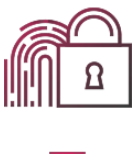
Security Compliance
Translates thousands of complex regulatory requirements into actionable security best practices
Benefits:
24/7 Security Monitoring Across Check Point Software Blades
- Continually ensures that management, software blades, and security gateways are configured properly
- Highlights poor configuration settings and security weaknesses
- Provides actionable recommendations for security improvements
Real-Time Security Alerts
- Simulates the security impact of configuration changes before installation
- Instant notification on security policy changes negatively impacting security
- Educates users on the broader impact of the desired change
Audit Ready Reports
- Translates thousands of complex regulatory requirements into actionable security best practices
- Delivers real-time assessment of compliance with major regulations
- Compliance Software Blade can be expanded to GRC capabilities with Check Point easy2comply
Features:
Security Best Practices
Check Point Compliance examines your environment’s security gateways, software modules, policies and configuration settings in real-time. With over 300 Security Best Practices, Compliance detects poor configurations and provides instant remediation tips to ensure your business stays secure. Compliance enables your security teams to reach the full potential of all of their Check Point products by recommending adjustments to security configurations in order to meet regulatory and Security Best Practices in place.
New Gaia User Best Practices
Create best practices by running scripts over GAiA OS on the gateways.
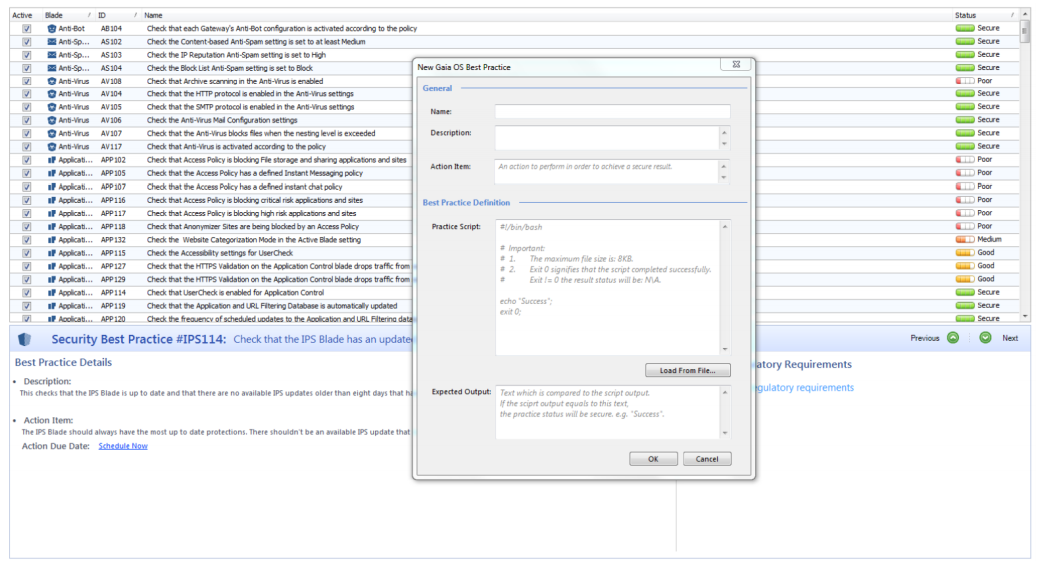
Regulations & GDPR
Check Point Compliance provides best practices that are mapped to industry-known regulations with clear requirements and recommendations laid out. Easily categorize by protections in place, or by severity of the security violation.
Compliance with the General Data Protection Regulation (GDPR) will require a focus on how privacy and data protection are addressed in the handling of information, but also on related areas such as awareness, incident management and achieving “data protection by design”.
Though GDPR is not a security-based regulation, there are aspects related to data protection and the security of an enterprise. Hence, Check Point family of technologies and products can be of a benefit to such enterprises when designing the data protection guidelines of the organization based on the data protection policy. Check Point Compliance contains several GDPR requirements that can be covered easily by configuring Check Point products accordingly.
Automated Trusted Advisor
Check Point Compliance governs multiple software technologies
within the Check Point protection suite and can provide a wide
view of your compliance level. You can even activate SmartEvent
for enhanced reporting capabilities.
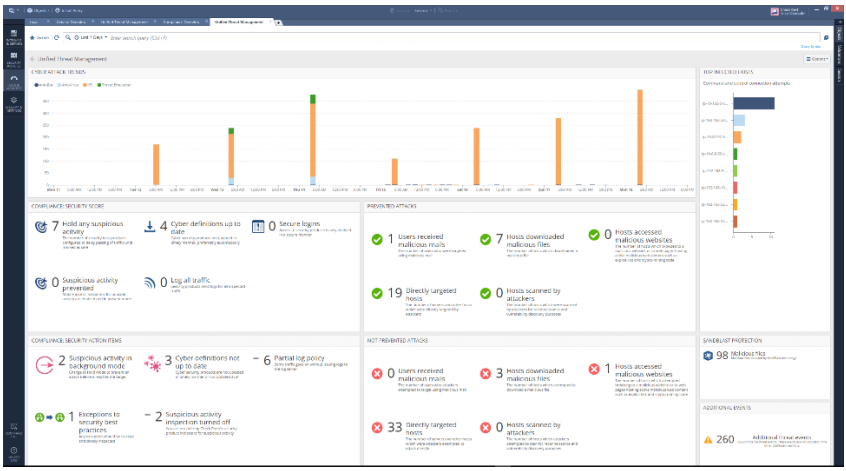
Security Compliance
With continuous monitoring, avoid human errors and lower the
complexity of managing cyber security with the ability to go from
view to action. Create overviews and reports in real-time and
manage it all through a single pane of glass.
Security Best Practices
Filter security best practices by software module. You can view
the relevant objects the best practice applies to as well as the
relevant regulatory requirements. Take action immediately or
schedule the action to occur at a later date.
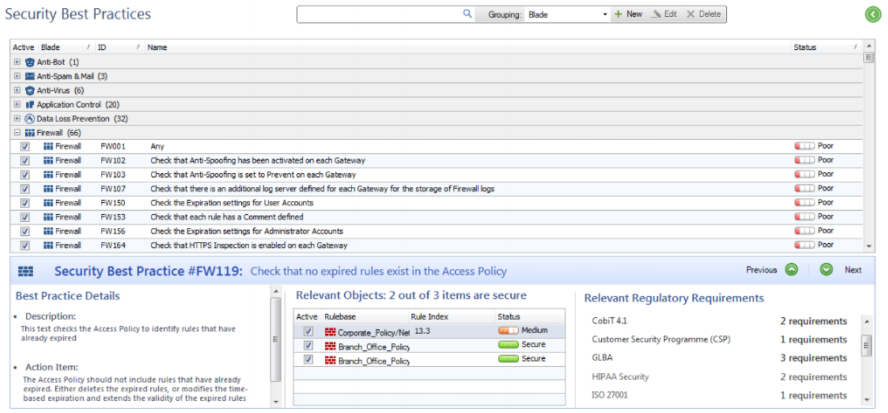
Creating a Best Practice
Fine tune and monitor what’s important to you. Easily
optimize your security best practices or create and enforce your
own best practices company-wide.
Regulatory Compliance
You can see your security level in accordance to direct
regulations such as HIPAA, GDPR, PCI DSS, ISO 27001 and many more.
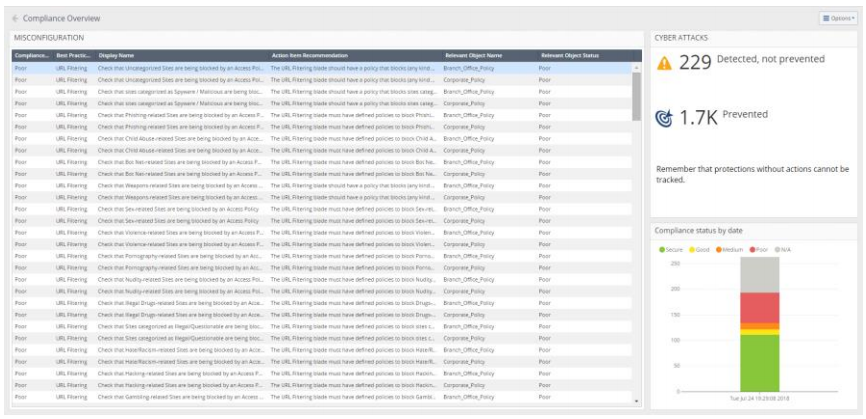
Specifications:
Compliance Specifications
| Supported Features | Details |
|---|---|
| Platforms | Management, Multi-Domain Management |
| Opperating Systems | GAiA, SecurePlatform, Windows |
| Versions | R75.40, R75.45, R75.46, R76, R77 |
| Software Blades | Firewall, IPSec VPN, Mobile Access, IPS, Anti-Bot, Anti-Virus, Anti-Spam & Email Security, Identity Awareness, Application Control, URL Filtering and DLP |
Supported Regulations
| ID | Regulation | Description |
|---|---|---|
| 1 | ISO 27001 | International framework for the management of information security |
| 2 | HIPAA | Patient data protection act for healthcare in the U.S.A. |
| 3 | PCI DSS | Global framework for the protection of credit card data |
| 4 | DSD | Australia's top 35 IT security mitigation strategies |
| 5 | GLBA | U.S. regulation related to financial privacy and safeguards |
| 6 | NIST 800-41 | Guidelines on firewalls and firewall policy from NIST |
| 7 | ISO 27002 | Implementation guidelines for each of the 133 control objectives defined within ISO 27001 |
| 8 | NIST 800-53 | Recommended security controls from NIST. Key document for FISMA and FIPS 200 requirements |
| 9 | CobiT 4.1 (IT SOX) | IT goals for ensuring system security. CobiT is also used as the basis for IT SOX compliance |
| 10 | UK Data Protection Act | UK law that governs the protection of personal data |
| 11 | DISA Firewall STIG | Technical paper detailing guidelines to configure firewalls |
| 12 | GPG 13 | Good Practices Guide defines best practices from the UK government |
| 13 | NERC CIP | Cyber security requirements for utility companies in the USA |
| 14 | MAS TRM | Technology Risk Management guidelines for the Monetary Authority of Singapore |
| 15 | SOX | Refers to the IT controls defined in the CobiT framework. The framework supports governance of IT by defining and aligning business goals with IT goals and IT processes |
| 16 | FIPS 200 | A requirement under FISMA that requires Federal organizations to comply with the Recommended Security Controls specified in NIST 800-53 |
| 17 | APP | The Australian Privacy Principles (APPs) replace the National Privacy Principles and Information Privacy Principles and apply to organisations, and Australian, ACT and Norfolk Island Government agencies. The APPs reference here are taken from Schedule 1 of the Privacy Amendment (Enhancing Privacy Protection) Act 2012, which amends the Privacy Act 1988. |
| 18 | CJIS | CJIS is the Criminal Justice Information Services Security Policy. The essential premise of the CJIS Security Policy is to provide appropriate controls to protect the full lifecycle of CJI, whether at rest or in transit. CJIS is divided into 12 individual policy areas. The controls listed here are referenced in Version 5.2, dated 08/09/2013. |
| 19 | Katakri | Katakri 3.0 refers to the Finnish National Security Authority's National Security Auditing Criteria. Katakri is divided into four sub-divisions: Administrative, Personnel, Physical, and Information Assurance. The mapping provided by Check Point has focused on Information Assurance. Katakri provides different levels of security requirements. The Check Point Katakri mapping is based on 'Requirements for the base level (IV)'. |
| 20 | PPG234 | This prudential practice guide (PPG) aims to assist regulated institutions in the management of security risk in information and information technology (IT). It is designed to provide guidance to senior management, risk management and IT security specialists (management and operational). |
| 21 | POPI | The Protection of Personal Information Act, 2013, is an official act of the Republic of South African parliament. This report refers specifically to Chapter 3 (Conditions for Lawful Processing of Personal Information), and more specifically Condition 7.19, Security Safeguards - Security measures on integrity and confidentiality of personal information. |
| 22 | Statement of Controls | This report identifies the core control requirements of the Check Point Security Management, Security Gateways and Software Blades. All relevant security best practices have been mapped in line with Check Point recommendations. This report allows Check Point users to verify the status of their Check Point security environment and to ensure that it is in line with Check Point's recommendations. |
| 23 | CIPA | The Children's Internet Protection Act (CIPA) place restrictions on the use of funding that is available through the Library Services and Technology Act, Title III of the Elementary and Secondary Education Act, and on the Universal Service discount program known as the E-rate (Public Law 106-554). These restrictions take the form of requirements for Internet safety policies and technology which blocks or filters certain material from being accessed through the Internet. |
| 24 | N-CIPA | The Neighborhood Children's Internet Protection Act (NCIPA) place restrictions on the use of funding that is available through the Library Services and Technology Act, Title III of the Elementary and Secondary Education Act, and on the Universal Service discount program known as the E-rate (Public Law 106-554). These restrictions take the form of requirements for Internet safety policies and technology which blocks or filters certain material from being accessed through the Internet. |
Top Tier Views:
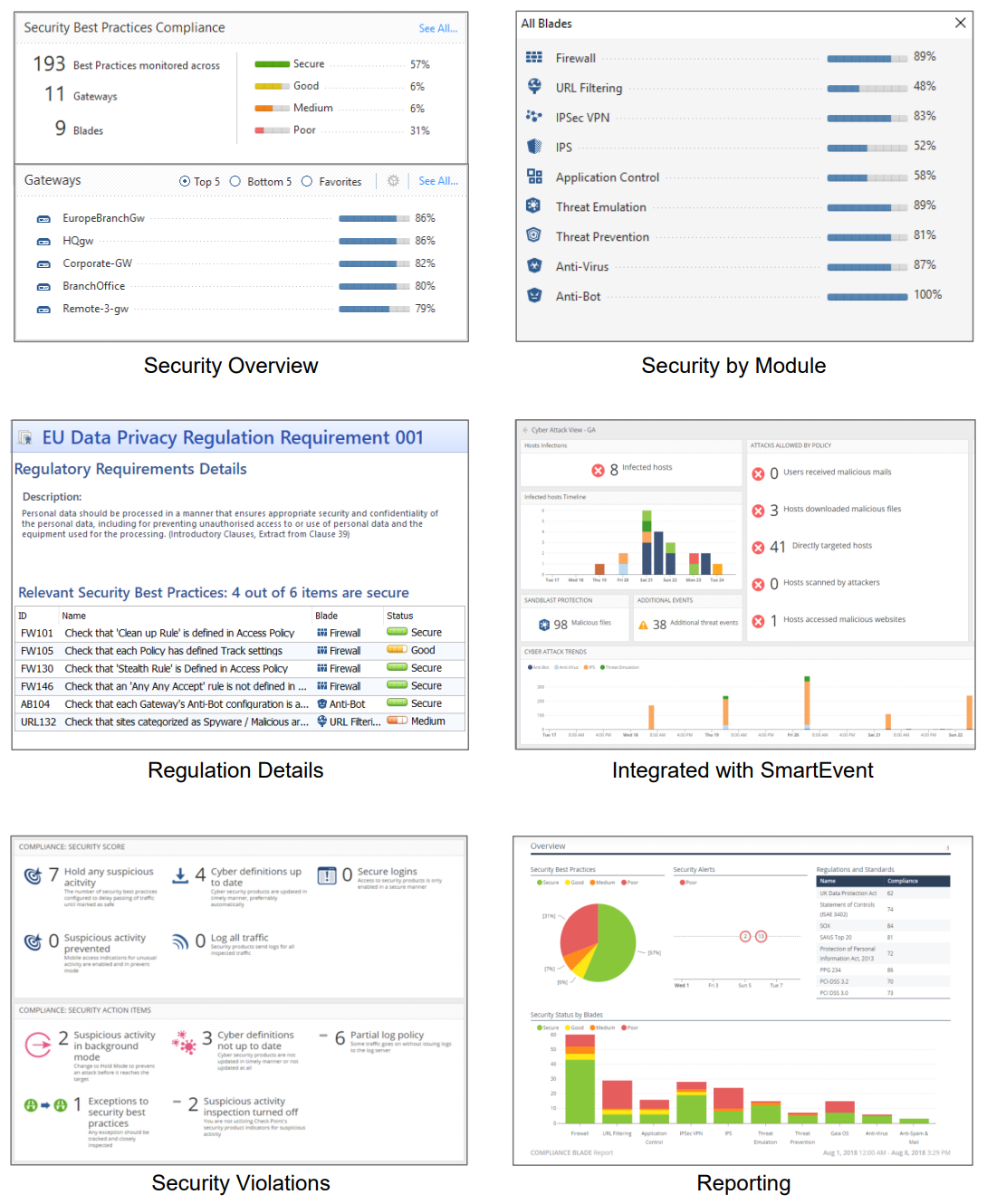
Documentation:
Download the Check Point Compliance Datasheet (PDF).

